(I’m still finishing my series of posts about a trip my wife and I took to Australia last month. This is the second-to-last of the Australia posts.)
We made our way into downtown Cairns, returned our rental car, and hooked up with our live-aboard dive boat, the Spirit of Freedom. It’s nice and big, we have a room with a private bathroom, a double bed, and four portholes. Good stuff.
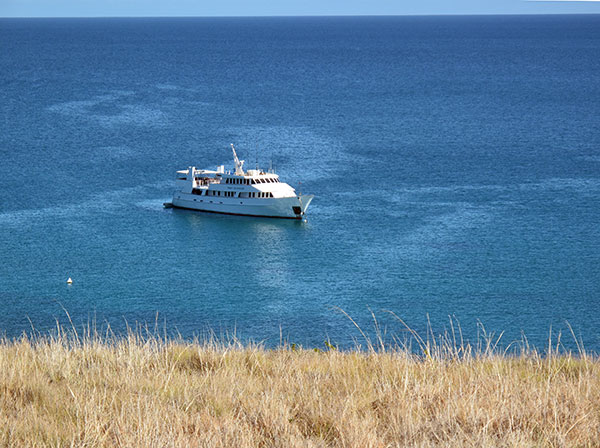
[Our boat.]
We tooled out about thirty miles to the Saxon Reef and did two dives. It turns out the Great Barrier Reef isn’t the one big monolithic thing, it’s more like a series of medium-sized reefs (like Saxon Reef) lined up along a curve that’s a couple of hundred miles long.
On Saxon Reef, we saw sharks, a turtle and some giant clams—I mean giant as in four feet across. I worship these creatures, they’re like yonic gods, embodiments of the female creative force, each of their cracks veiled by mantle bearing an elegant one-of-a-kind leopard-spot Turing pattern, and with fringed holes in the mantle displaying the clam-goddesses secret innards—disks and fringes of a creamy white.
And then we steamed all night to the vicinity of Ribbon Reef #10 (another feature of the Great Barrier Reef), maybe a hundred miles from Cairns. It was raining most of the time.
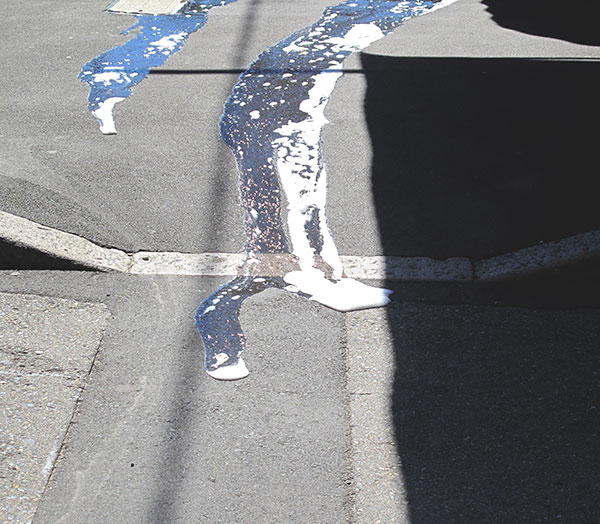
[More or less irrelevant picture of wash-up water running down a Sydney sidewalk.]
The rocking of the boat got to me over the evening, and when they set a plate of roast beef and mashed potatoes in front of me for supper, I went up to our room and filled two sickbags with puke. They told us the bags are of rice-paper, which disintegrates quickly in the water, and what we should throw them overboard after filling them. “The fish all come. For them, it’s Christmas.”
I slept badly, waking every hour on the hour like a cuckoo clock. Outside the portholes, the clouds had cleared up, and the moon was laying down a wrinkled highway of light upon the waters. The boat wallowed along, rocking us, with my stomach empty it felt okay.
I’d been anxious about diving again, it had been over two years. Sylvia was just snorkeling, and for the few dives I buddied up with a guy named Mike, about my age, and with a comparable amount of dive experience—something like sixty dives—and it worked out fine. The only difficulties were that I’m slightly stopped up, so I had to work hard at clearing my ears by pinching my nose and blowing.
There are a variety of thoughts that I usually have while diving.
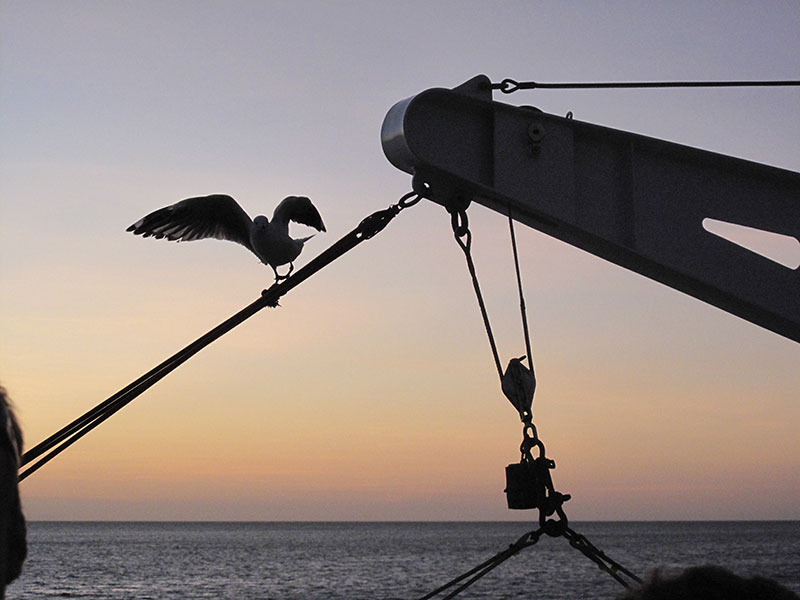
[Gull on a spar aboard the Spirit of Freedom.]
Often, at the start, I’ll be rushing, swimming fast, as if I was going to find something different around the next coral head. Really, everything is pretty much everywhere, the reefs and the undersea environment are a fractal, and if you look twice as hard at a given spot, you see three times as much.
Another common thought is, after about ten minutes, I’ll think, “Okay, I’ve seen it all, I’m done, can I get out now?” But really, you want to empty out your tank and stay in about forty minutes. So you relax and absorb more. It’s more like listening to a long symphony than like having sex. It’s not that you reach a peak and are done.
I always worry about my air supply a little bit, but over the years, I’ve gotten pretty good and stretching it out.
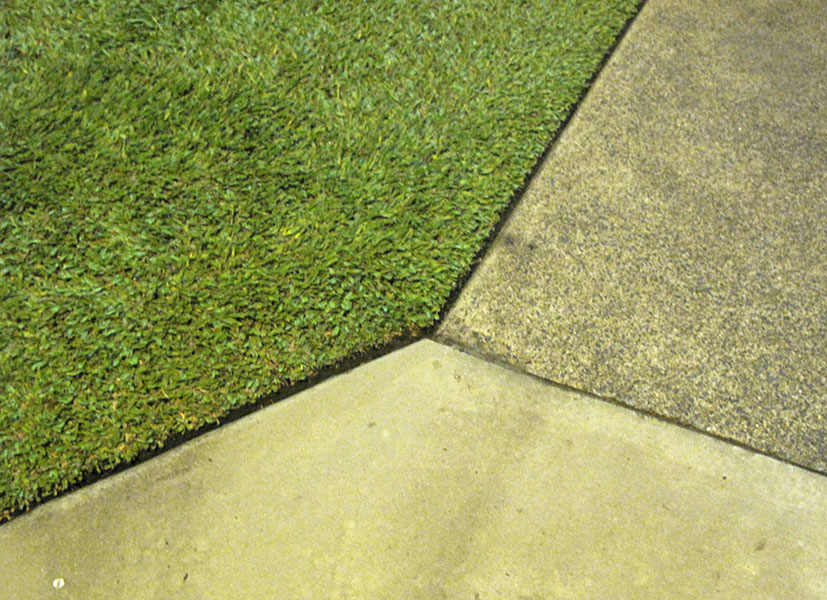
[Partioning the space of all possibilities.]
One of the really discombobulating things about diving is that you can’t just—stop. On land, if I really want to stare at something, I hunker down and stare for as long as I like. But in the water, I’m always drifting—propelled by currents, the motions of my limbs, and the varying buoyancy of my body as I breathe in and out. I can’t sit still. Sometimes, I do in fact make myself heavy and sit or kneel on the sandy bottom, just to have a moment of rest.
On the second morning at 7 a.m. we dived a so-called bommie, by the name of Pixie Peak. “Bommie” is from an Aboriginal word “bomara” that means underwater mountain. I’d thought I might not be up that early, but I was all too glad to leave my uneasy bed at 6:30 a.m. Pixie Peak is a ninety-foot high tower of coral, about thirty feet across, kind of a butte. We dropped down to the bottom, and wound our way up around it, our path like a barber-pole stripe.
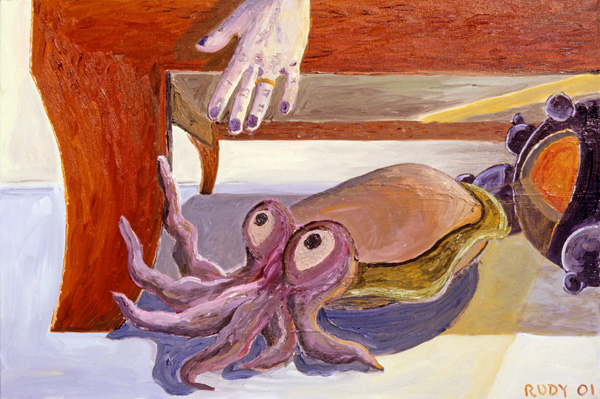
[My 2001 painting “Under My Bed” of a cuttlefish. See my paintings page for more info.]
My dive buddy and I got down to ninety feet before the others, and the first very first thing I saw was a giant cuttlefish—be still my heart. He was easily two feet long, maybe three, just like one I painted in Under the Bed as a preliminary to imagining my space-cuttlefish character Professor Bumby in Frek and the Elixir.
The cuttlefish had his facial squid-bunch of tentacles demurely gathered into a cone pointing my way. His (or her) eyes had an unfathomable expression, due to the pupils being shaped like the letter W. The hula-skirt frill-fin that circles the bulk of his body was in constant motion, easing him backwards away from me, his eldritch eyes tracking my movements. I noticed that his skin flickered very rapidly, changing its shade as rapidly as jump-cuts in a video.
Looking at some of the bright little damsel fish along the wall of the bommie, I was stuck by how really awkward they are. Their only tools for delicate maneuvers are these two little paddle fins on their sides by their gills. And at any time, random tendrils of current are canting them to one side or the other. I feel an affinity for the damsel fish—I imagine that I’m in control of my life, but really all I have are a pair of awkward paddle fins, flailing away at the sea of reality, which is so richly braided with intricate currents I can neither anticipate nor control.
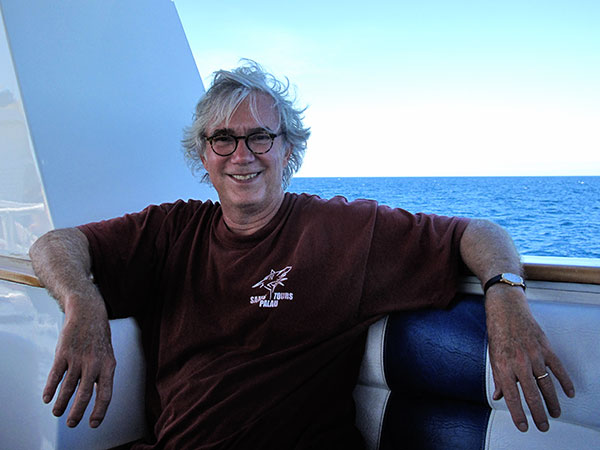
I skipped the second SCUBA dive that day, at Challenger Bay (still part of the Great Barrier Reef), and took Sylvia snorkeling instead. This was in fact a really good spot for it, as the reef rose up to acres of shallows. We swam along in waters ten feet deep, feasting our eyes on the wack corals: staghorn heads filled with clans of damsel fish, shelf corals with flowery cod hiding in their shade, dozens of giant clams, thick pimply sea hares—like sea cucumbers, but bigger and creamy white with brown spots. Since Sylvia and I were doing most of our swimming with our big flipper fins, we held hands or linked arms, it was nice to be together with her, flying over this alien, jumbled paradise.
In the evening I went for a night dive—this was the first really good night dive I ever had. We came back to the same relatively shallow reef where Sylvia and I had snorkeled. Each diver had a flashlight in hand and a glowstick mounted on his or her tank. The guides had mentioned that the coral might be spawning—they usually do it a few days after the full moon in November or December, and we’d just had a full moon the other day. We did indeed find some spawning coral.
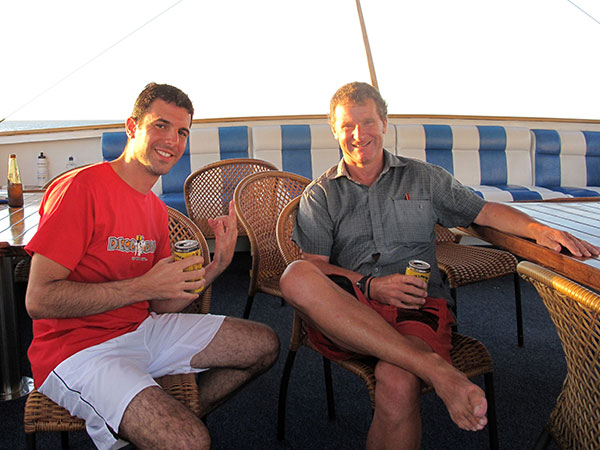
[Two of my dive buddies, Mark (left) and Mike (right).]
Keep in mind that a coral reef is a colony of individual polyps, each in its own little stony niche. When they spawn, some of the polyps send out clouds of sperm, and others push out little pink eggs the size of a BB, or a bit smaller. Worms, fairy shrimp, small fry, and sea lice crowd around the spawning reef, eating as much of the bounty as the can. Each little spot on the reef becomes a scene of great activity, reminding me of Times Square at New Years Eve, albeit on a very small scale. Some of the sea lice were nipping my scalp and my hands.
There were dozens of big trevalley fish around us, each of them two or three feet long, maybe twenty pounds—they were fascinated by our flashlight beams, and hoping to eat any smaller fish that we highlighted.
In the coral I saw bright red beads shining in the light, looking close I could see these were the eyes of tiny little red shrimp nestled in nooks. Some large purple nudibranchs (or sea slugs) were on the crawl, out to mate with each other. They were like big velvety washrags or dishtowels, with a soft pair of feelers at one end. A night of sex on the reef.
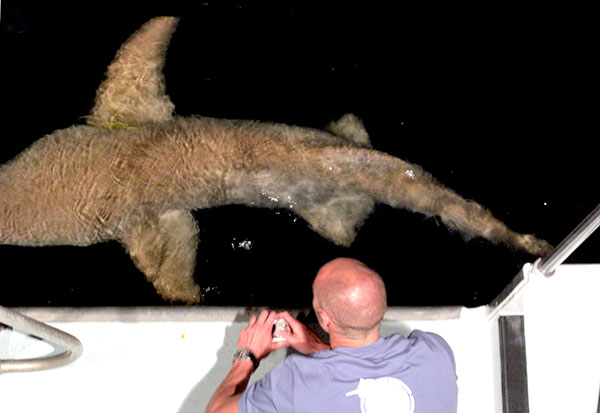
[After our dive, a nurse shark came up to the back of the boat wanting food. That’s my third dive buddy, Daniel from Italy, there. He did the night dive with me.]
After the night dive we got brownies with chocolate syrup and whipped cream. There’s a sense that you can eat any amount of food if your diving. This said, I didn’t sleep very well. I got with insomnia and did yoga on the deck for awhile. It feels extraterrestrial to have all different constellations in the sky. I think I saw the Southern Cross.
We dived another cylindrical bommie-tower the next day. A great sea turtle perched on a ledge of this bommie, like an eagle in his aerie. But, unlike an eagle, he was unperturbed by seeing a dozen divers wallow by.
The last dive was kind of exciting, as we were trying to complete a fairly long route around three or four bommies—and we swam rather deep. I was kicking overly hard, and I ran out of air before we could finish our plan. I surfaced with my current dive buddy, a young guy called Marc, and we saw we were a couple of hundred yards from the ship. Marc still had plenty of air, so we wallowed along just under the surface. But the closer we got to the ship, the stronger the currents got. I didn’t have the strength for the last fifty yards. An inflatable lighter from the ship was buzzing around, and I got him to pick us up, which was exciting. By now the surf was so high that the lighter couldn’t really dock to the ship, we had to jump out as the waves sent the little boat hurtling by.
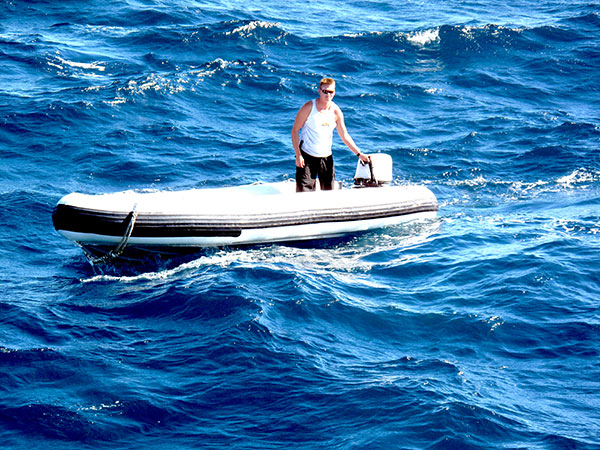
[Rescued from the current by a lighter.]
I did eight dives in three days, and one snorkel session. Actually I would have liked to snorkel more—I tend to see more when I’m snorkeling, and there’s less time pressure, and less of a need to stay close to your buddy.
The Great Barrier Reef is certainly better than any of the sites I’ve visited in Mexico, Hawaii, or the Turks and Caicos Islands. In general, South Pacific sites like the Great Barrier Reef have, I think, brighter fish and more interesting coral—including the so-called soft coral, which is floppy and leathery.
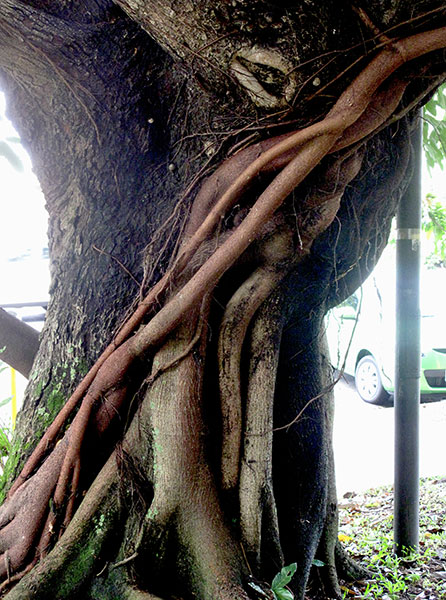
[A land tree with a strangler-fig growing down it.]
In terms of the South Pacific sites, I think Fiji, Tonga, Micronesia, and Palau are certainly as good or maybe even a little better than the Great Barrier Reef. I’d still have to say Palau has the best boat dives, and more awesome walls. And Fiji, Tonga, and Pohnpei have the virtue of having good snorkeling areas that you can swim to right off shore—it really takes a boat to get out to the Great Barrier Reef from the mainland of Australia.
But it was totally worth going to see the Barrier Reef, and good to be in the water again. Diving’s really pretty easy, I remembered—as I always do.









December 30th, 2009 at 6:09 pm
Some major good hair days, professor. You got it all over that young reptile pal of yours.
December 31st, 2009 at 11:22 am
Different constellations: What i found most baffling was that all of it rotates the ‘wrong’ way around. Did you notice this? Sure, the sun rises in the East and sets in the West … but rises through the North. It’s in the South that its never been seen. It almost knocked me off my chair when i realised this.